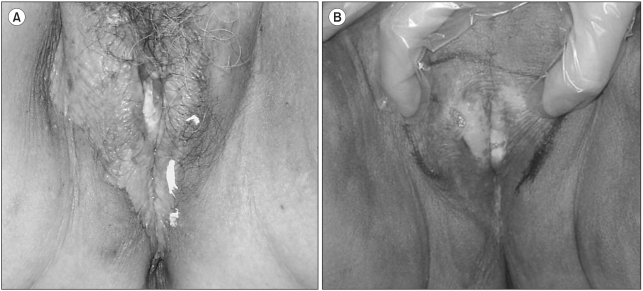Cancer Res Treat.
2005 Dec;37(6):365-369.
The Role of Radiation Therapy for the Extramammary Paget's Disease of the Vulva ; Experience of 3 Cases
- Affiliations
-
- 1Department of Radiation Oncology, The Catholic University of Korea College of Medicine, Seoul, Korea. scyoon@cmc.cuk.ac.kr
- 2Department of Gynecology, The Catholic University of Korea College of Medicine, Seoul, Korea.
- 3Department of Pathology, The Catholic University of Korea College of Medicine, Seoul, Korea.
Abstract
- We have experienced three cases of extramammary Paget's disease (EMPD) of the vulva that received radiation therapy (RT). Here, we analyze the efficacy of RT and include a literature survey. Three patients with EMPD of the vulva were treated with curative RT between 1993 and 1998. One of the patients had associated underlying adenocarcinoma of the vulva. The total doses of radiation administered were 54~78 Gy/6~8 weeks. Radiation fields encompassed 2 to 3 cm outer margins free from all visible disease including or not including the inguinal area using a 9 MeV electron or a 6 MV photon beam. Follow-up durations after radiotherapy were 0.6~11 years. Complete response was obtained in all three patients. Marginal failure occurred in one patient, and another patient with underlying adenocarcinoma treated by vulvectomy with bilateral inguinal lymph node dissection followed by external RT showed no relapse. Radiation induced side effects were transient acute confluent wet desquamation in the treated area resulting in mild late atrophic skin changes. Although surgery is currently considered the preferred primary treatment for EMPD, it has a high relapse rate due to the multifocal nature of the disease. We conclude that RT is of benefit in some selected cases of EMPD.
Keyword
MeSH Terms
Figure
Reference
-
1. Besa P, Rich TA, Delclos L, Edwards CL, Ota DM, Wharton JT. Extramammary Paget's disease of the perineal skin: role of radiotherapy. Int J Radiat Oncol Biol Phys. 1992; 24:73–78. PMID: 1324902.
Article2. Parker LP, Parker JR, Bodurka-Bevers D, Deavers M, Bevers MW, Shen-Gunther J, et al. Paget's disease of the vulva: pathology, pattern of involvement, and prognosis. Gynecol Oncol. 2000; 77:183–189. PMID: 10739709.
Article3. Eliezri YD, Silvers DN, Horan DB. Role of preoperative topical 5-fluorouracil in preparation for Mohs micrographic surgery of extramammary Paget's disease. J Am Acad Dermatol. 1987; 17:497–505. PMID: 2821087.
Article4. Crocker HR. Paget's disease affecting the scrotum and penis. Trans Pathol Soc London. 1889; 40:187–191.5. Chanda JJ. Extramammary Paget's disease: prognosis and relationship to internal malignancy. J Am Acad Dermatol. 1985; 13:1009–1014. PMID: 3001158.
Article6. Coldiron BM, Goldsmith BA, Robinson JK. Surgical treatment of extramammary Paget's disease. A report of six cases and a reexamination of Mohs micrographic surgery compared with conventional surgical excision. Cancer. 1991; 67:933–938. PMID: 1846769.
Article7. Luk NM, Yu KH, Yeung WK, Choi CL, Teo ML. Extramammary Paget's disease: outcome of radiotherapy with curative intent. Clin Exp Dermatol. 2003; 28:360–363. PMID: 12823291.
Article8. Moreno-Arias GA, Conill C, Sola-Casas MA, Mascaro-Galy JM, Grimalt R. Radiotherapy for in situ extramammary Paget disease of the vulva. J Dermatolog Treat. 2003; 14:119–123. PMID: 12775320.
Article9. Moreno-Arias GA, Conill C, Castells-Mas A, Arenas M, Grimalt R. Radiotherapy for genital extramammary Paget's disease in situ. Dermatol Surg. 2001; 27:587–590. PMID: 11442599.
Article11. Burrows NP, Jones DH, Hudson PM, Pye RJ. Treatment of extramammary Paget's disease by radiotherapy. Br J Dermatol. 1995; 132:970–972. PMID: 7662577.
Article12. Brierley JD, Stockdale AD. Radiotherapy: an effective treatment for extramammary Paget's disease. Clin Oncol. 1991; 3:3–5.
Article
- Full Text Links
- Actions
-
Cited
- CITED
-
- Close
- Share
- Similar articles
-
- A Case of Vulvar Paget's Disease
- A Case of Paget's Disease of the Vulva
- A Case of Diffuse Extramammary Paget's Disease of Vulva and Anus Showing a Good Response to Radiotherapy
- A Case of Extramammary Paget's Disease and Candidiasis of the Vulvar Area
- Two cases of surgically treated extramammary Paget's disease guided by photodynamic diagnosis




